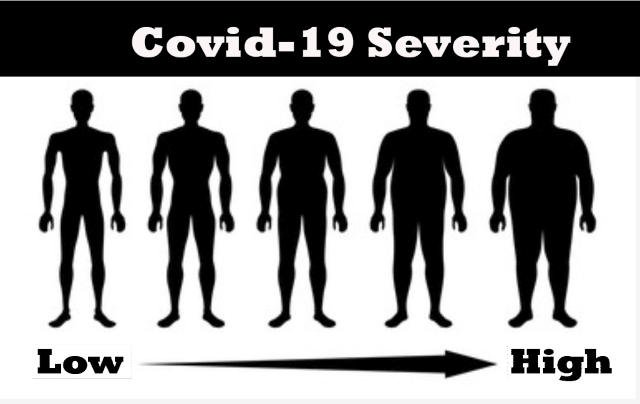There may be a potential relationship between obesity and aggravated COVID-19 response. This meta-analysis found that severe patients had a higher body mass index (BMI) compared to non-severe patients.
Also, obese and overweight COVID-19-infected patients are more likely to require ICU care and mechanical ventilation than normal healthy patients.
Once, obesity or excessive body fat was seen as a sign of wealth and affluence in many nations—where a vast majority of people suffer from malnutrition and poverty—though the conception has changed almost everywhere over time. With the advancement of medical research, a high number of scientific reports have established a link between obesity and increased risk of hypertension, diabetes, cardiovascular disease, cancer, and inflammation in the last two decades. Still, a vast majority of people, more than 1.9 billion adults in 2016 (WHO), are overweight or obese worldwide, the condition has been pandemic in many countries, including the USA (Fryar et al., 2016).
Another pandemic, COVID-19, caused by the SARS-CoV-2 virus, has become the colossus suffering of the global human community since the first patient was identified on December 31, 2019, in Wuhan, China. So far, while this report was prepared on August 13, 2020, the virus has infected over 20,875,703 people and claimed 748,381 deaths worldwide.
Emerging reports have indicated that people with comorbidity like hypertension, diabetes, cardiovascular disease, renal disease, and respiratory disease are more likely to develop severity than others.
Recent reports also indicated that obese people infected with the virus often require ICU care and have a high mortality rate. At the same time, some authors suggested that no BMI (body mass index expressed as weight in kg per meter squared height, kg/m2) difference exists between severe and non-severe patients.
This analysis reviewed existing literature and conducted a meta-analysis to establish if there exists any relationship between disease severity and increased BMI.
Methods
A comprehensive literature search was conducted in PubMed and Google Scholar using the keywords ‘obesity’, ‘BMI’ in combination with ‘novel coronavirus’, ‘COVID-19″, ‘2019-nCoV’, ‘SARS-CoV-2’, without applying language on August 9, 2020.
After pulling all literature in Endnote software, this study removed all duplicates and shortlisted pooled articles by reviewing the title and abstract. Original retrospective studies reporting the prevalence of obesity in severe vs non-severe and/or survivors vs deceased patients were included in the meta-analysis. Case reports, comments, letters to the editors, and reviews were excluded.
The study used the DerSimonian–Laird method to calculate pooled results of proportion at their respective 95% confidence intervals (CI). The analysis used the Inverse-Variance method for the comparison of mean difference (MD) with 95% confidence interval (CI), and the Random Effects model for calculation.
Results
The search retrieved 52 articles, of which 15 were duplicates. After reviewing the title and abstract, the study assessed 27 articles for full-text review. Finally, ten articles (Alkhatib et al., 2020, Cai et al., 2020, Cai et al., 2020, Deng et al., 2020, Huang et al., 2020, Kalligeros et al., 2020, Nakeshbandi et al., 2020, Pettit et al., 2020, Rottoli et al., 2020, Simonnet et al., 2020) were found consistent for full inclusion criteria and included in the qualitative synthesis and meta-analysis. All studies were retrospective: four studies originated in China; others were from the USA.
A total of 2355 participants enrolled in this meta-analysis. Among the participants, 716 patients enrolled in the studies conducted in China are divided into two groups: BMI <28 and BMI >28. Other participants are categorized into three groups: normal (BMI <25), overweight (BMI 25 to 29.9), and obese (BMI >30). The prevalence of severity was calculated in BMI <28 and BMI>28 groups; however, both the severity and mortality were calculated in the normal, overweight, and obese categories. The study also compared mean BMI in severe and non-severe patients.
Comparison of Disease Severity
BMI >28 vs <28
The study assessed a total of 716 participants for the disease severity in BMI>28 vs <28 groups. For data analysis, 713 individuals were available. The prevalence of obesity (BMI >28) was 29.17%. The study found that disease severity is more likely to happen in patients with BMI larger than 28 compared with BMI lower than 28 (RR 3.60, 95% CI 1.75 to 7.38; I2 =79%), Figure 1.

Normal vs Overweight
The study enrolled a total of 878 patients in this category. Of the total patients, 458 were overweight. The prevalence of overweight was 52.16%. Data analysis found that overweight patients had a higher proportion of disease severity compared with normal patients (RR 1.59, 95% CI 1.18 to 2.12; studies = 5; I2 = 0%), Figure 2.

Normal vs Obese
Five included studies compared patients with a BMI higher than 30 with normal patients for the prevalence of severity. Data analysis found that obese patients had a higher proportion of severe cases compared with normal patients (RR 2.09, 95% CI 1.17 to 3.74; participants = 993; studies = 5; I2 = 79%), Figure 3.

Comparison of Mortality
In this category, the study enrolled a total of 1224 patients. Of the total patients, 384 were normal (BMI >25), 375 were overweight (BMI 25 to 29.9), and 465 patients were obese (BMI >30).
The analysis found that overweight patients had a higher mortality proportion than normal patients (RR 1.28, 95% CI 1.03 to 1.61; I2 = 45%), Figure 4.

The analysis also found a higher proportion of mortal patients in the obese group when compared with the same in the normal group (RR 1.25, 95% CI 1.00 to 1.56; studies = 3; I2 = 6%), Figure 5.

Comparison of Mean BMI in Severe vs Non-severe Patients
This study also assessed mean BMI in severe vs non-severe patients. A total of 694 patients, 346 severe, were enrolled in this category. The study found that severe patients had higher BMI (overall mean BMI 32.25, CI: 28.66 to 35.83, P < 0.001) compared to the non-severe patients (overall mean BMI 28.13, CI: 25.49 to 30.78, P < 0.001) and the difference was statistically significant (MD 3.87, 95% CI 2.35 to 5.38; P < 0.00001), Figure 6.

This study found that overweight or obese COVID-19 patients are more likely to develop severity and require ICU care and mechanical ventilation compared with normal healthy patients. The study also found severe patients had higher BMI compared to non-severe patients. When assessed for the prevalence of mortality, the study also found overweight or obese patients had a higher proportion of the outcome.
There are several possible ways to describe overweight or obese patients who are more likely to develop severity when infected with COVID-19.
First, the ACE-2 receptor, which the virus SARS-CoV-2 uses to get entry into the host cells, is overexpressed in adipose tissue, the tissue obese people have more than the healthy individual, in general.
Second, an overactivated immune response—people in obesity more likely have—may lead to a higher chance of cytokine storm in obese people infected with the virus.
Third, diminished lung function—a result of increased abdominal pressure and reduced chest expansion—causes obese people to experience higher resistance in respiration, leading to difficulty in improving oxygen saturation levels. Last but not least, obesity is linked with metabolic disease syndromes like hypertension, cardiovascular disease, and diabetes, which are shown to increase mortality risk and disease severity.
Overall, this analysis found people with obesity may have aggravated COVID-19 severity mostly related to the overexpressed ACE-2 receptor, overactivated immune response, diminished lung function, and associated comorbidity.
Certain limitations exist in this study. Higher heterogenicity among the studies, limited samples, and publication bias are a few of them.
The author declares no conflict of interest.
Author: Molay Roy, PhD; Orchid ID: 0000-0002-8236-7265
© 2020 sciencetrend.ca | All rights reserved



















